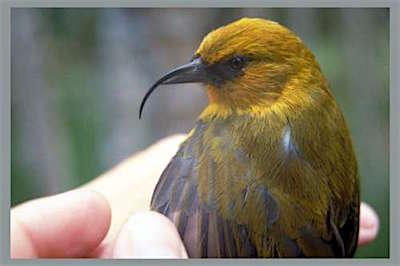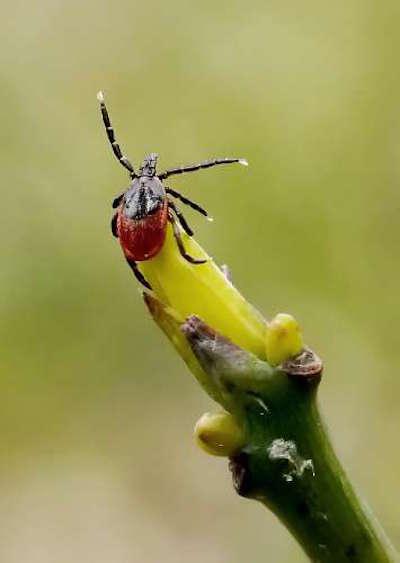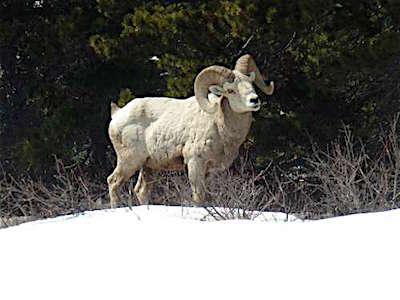Editor's note: The following article was written by Marisa Lubeck of the USGS.
From striking craggy pinnacles to cavernous underground lairs, the national parks are renowned for their grand wildernesses. However, the inhabitants of these landscapes – the wilds’ wildlife – are perhaps the most beloved of the parks’ draws. Animals of the national parks, including many threatened or endangered species, also provide a significant scientific service: They are indicators of the overall health of their environments.
The U.S. Geological Survey is the lead federal agency for wildlife disease research and surveillance throughout the nation, helping managers protect valuable ecosystems and the animals that are fundamental to them. This work includes critical disease studies in the national parks and other federally protected lands. In celebration of the National Park Service centennial, the USGS reflects on some of its key wildlife disease projects in the parks.
A Colorful Project: Monitoring Mange in Yellowstone Wolves
Sarcoptic mange is a contagious canine skin disease caused by mites that results in hair loss, skin infections, irritation, and voracious scratching. Infected wolves are vulnerable to hypothermia, malnutrition, and dehydration, which can cause death and hush their hallowed howls.
As of March 2014, two of eight known wolf packs in Yellowstone National Park had mange, and the prevalence within packs ranges from 25 to 60 percent. The USGS studies the effects and extent of mange to help state and federal partners manage wolves in the park and in other wolf recovery areas throughout Montana, Wyoming, and Idaho.
Kaleidoscopically colored wolves depicted by thermal imaging can help compare temperature loss from mange patches to temperature loss from natural fur. Red-colored blotches in images of captive wolves reveal hairless areas that lose the most heat, which the scientists shaved to simulate mange hot spots. Researchers at the USGS Northern Rocky Mountain Science Center and their partners in Yellowstone National Park also place thermal remote cameras near deer and elk carcasses in the park to capture similar images of wolves with mange feeding in the wild.
Information gleaned from these studies may help determine potential characteristics of individuals or packs of Yellowstone wolves that predispose them towards mange, or why some wolves recover while others don’t.
A Soaring Challenge in Hawaii Volcanoes National Park
High elevation forests in the Kahuku Unit of Hawaii Volcanoes National Park are home to spectacular yet endangered bird species such as the akiapolaau, Hawaii akepa, and Hawaii creeper. Diseases like avian malaria have contributed to drastic reductions in the geographic range and numbers of these brilliant birds in the last century and can hinder restoration efforts. Climate change, invasive species, residential development adjacent to the park, and the introduction of new pathogens and vectors that transmit disease will likely intensify the impacts of avian disease on endangered forest birds in Hawaii.

Forests in the Kahuku Unit of Hawaii Volcanoes National Park are home to spectacular yet endangered bird species such as the akiapolaau honeycreeper, which are susceptible to various avian diseases/USGS
Scientists with the USGS Pacific Island Ecosystems Research Center and partners are collecting information about the distribution and prevalence of avian diseases in Kahuku, including surveys that document potential new vectors like the mosquito species Aedes japonicus. These baseline data can help managers successfully preserve and restore endangered forest birds in the park. Furthermore, ongoing studies of mosquito-borne avian diseases may potentially help understand zoonotic diseases beyond Hawaii and contribute to future rapid response efforts.
Battling Botulism in Great Lakes Birds
A paralyzing disease known as botulism has killed over 100,000 birds in parts of the Great Lakes since 1999, and caused extensive bird mortality in northern Lake Michigan near Sleeping Bear Dunes National Lakeshore. In 2012, over 4,000 botulism-afflicted birds were found dead on Lake Michigan beaches. Scientists with the USGS and partners are working with Sleeping Bear Dunes National Lakeshore to investigate avian botulism type E mortality events in the park. The goal of this and related Great Lakes Restoration Initiative (GLRI) projects is to develop management actions to reduce fish and bird mortality during botulism outbreaks in distressed Great Lakes environments.
Avian botulism is a deadly food poisoning of wildlife, caused by a toxin produced by the naturally occurring soil bacterium, Clostridium botulinum. The toxin likely accumulates in some invertebrate and fish species, which are then eaten by vulnerable water birds. Common loons with their signature haunting calls and federally endangered piping plovers are examples of species harmed by botulism outbreaks.

Ticks spread the widest variety of diseases that are harmful to humans, including Lyme disease.
GLRI partners collected 435 sediment samples during 2010-2012 near Sleeping Bear Dunes National Lakeshore and analyzed the samples for the presence of the botulinum toxin gene. Results from this analysis are used to understand the ways through which birds come into contact with the toxin.
Tick Talk: Disease Vectors in the Eastern United States
Tiny ticks spread the widest variety of diseases that are harmful to humans, including Lyme disease, which is more common in the northern United States than in the south. The USGS Patuxent Wildlife Research Center and partners are studying tick behavior in the Cape Cod National Seashore of Massachusetts and other federal sites in the eastern United States to determine how ticks choose their hosts and how such behaviors vary geographically.
In 2015, the scientists found that ticks in the north seek hosts on top of leaf litter and on twigs where they can contact people, while southern ticks hide out under the leaf litter surface where they are less likely to get on hikers. Also, ticks survive longer under northern conditions than under southern conditions, which may contribute to the north-south difference in host-seeking behavior.
These data and information about tick-host relationships, seasonal tick biology, and tick genetics can provide a better understanding of vector-borne disease ecology, help develop models that can predict patterns of disease spread as environmental conditions change, and improve management of Lyme disease.
Protection against Plague in Wind Cave National Park
Once thought to be extinct, the black-footed ferret is one of the most endangered mammals in North America, and sylvatic plague is a major impediment to its recovery. Scientists are testing a USGS-developed edible vaccine to prevent the spread of plague in prairie dogs, which ferrets depend on for food and shelter. One of the critical trial sites for the vaccine is Wind Cave National Park in South Dakota.
Sylvatic plague is a bacterial disease transmitted by fleas that affects many mammals, including humans. Both black-footed ferrets and prairie dogs are highly susceptible to the disease. Over the past century, prairie dog populations, and ferrets by extension, have drastically declined due to habitat loss, poisoning, and devastating outbreaks of plague. Prairie dogs can suffer high mortality rates of 90 percent or more during plague outbreaks, often resulting in local extinctions. The Utah prairie dog species is listed as threatened and the Mexican prairie dog is considered endangered in Mexico.
Plague vaccine injections can effectively immunize ferrets, but are unfeasible in free-ranging animal populations. As a possible solution to this dilemma, the USGS National Wildlife Health Center and partners cooked up a nutty idea: Vaccine disguised as food. The scientists developed a peanut butter-flavored, vaccine-laden oral bait that, when placed in critical habitats, can potentially immunize significant numbers of prairie dogs. The edible vaccine, which prairie dogs find delicious, is still being tested in the field, with Wind Cave National Park as a key trial site.

The USGS studies bighorn sheep movements, population structures, and habitat use in and near Glacier National Park/USGS
Bighorn Behavior in Glacier National Park
Statuesque atop rugged alpine landscapes, male bighorn sheep are instantly recognizable with burly horns that grow in Princess Leia-like spirals on either side of their husky heads. But despite their brawn, bighorn sheep across western North America are vulnerable to fatal diseases such as pneumonia, among others.
The USGS and partners are studying bighorn sheep movements, population structures, and habitat use in and near Glacier National Park to better understand how diseases affect these emblematic animals. As part of this research, scientists have collected GPS data and genetic and other samples on over 100 bighorn sheep east of the Continental Divide in Glacier National Park, Waterton National Park, and the Blackfeet Reservation. Specific projects include:
Movements relative to salt licks: Natural salt licks, or deposits of salt from which animals can obtain essential minerals, provide nutrients that strengthen sheep immune systems and may buffer bighorns from disease. The USGS uses GPS collar data to determine the timing and frequency of bighorn sheep movements toward known salt licks. Scientists also deployed two kinds of remote cameras in 2014 to evaluate ways to monitor sheep at one salt lick in Glacier National Park.
Population structure: Using data from captured bighorn sheep, scientists are evaluating the structure of the area’s sheep population, sheep movements, and disease prevalence and presence to assess threats such as disease and climate change.



Add comment